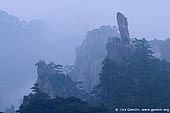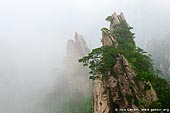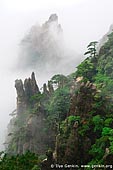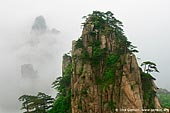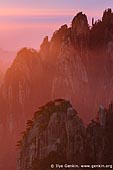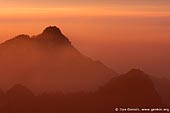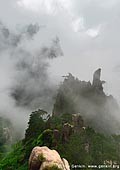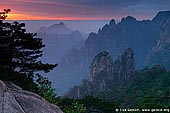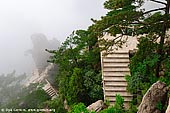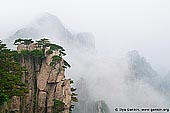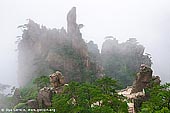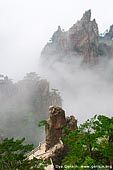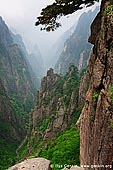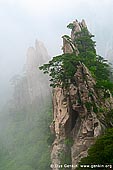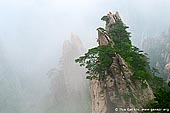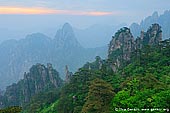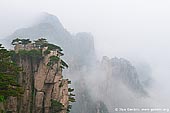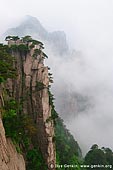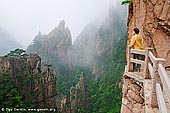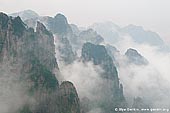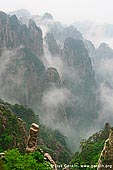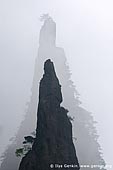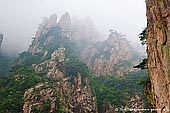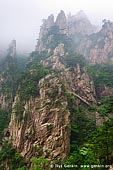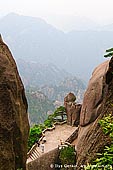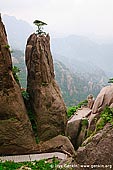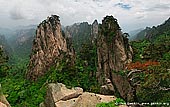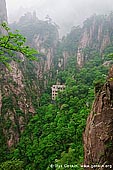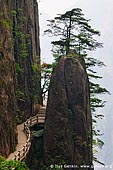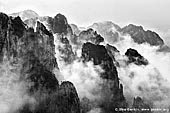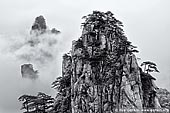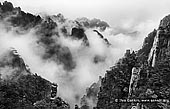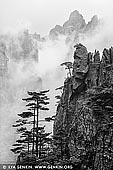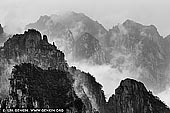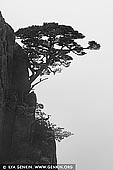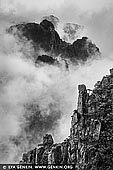Huangshan (Yellow Mountains)
Huangshan District, Anhui Province, China
Mount Huang, also known as Huangshan (literally "Yellow Mountain"), is a mountain range in southern Anhui province in eastern China. The area is well known for its scenery, sunsets, peculiarly-shaped granite peaks, Huangshan Pine trees, and views of the clouds from above. Mount Huang (Huangshan) is a frequent subject of traditional Chinese paintings and literature, as well as modern photography. Today, it is a UNESCO World Heritage Site and it is one of the most popular tourist attractions in China.
Huangshan is a granite massif consisting of 36 separate peaks, rising above 1,800 m. Famous throughout Chinese artistic history, Huangshan represents the typical mountain in Chinese paintings. Frequently shrouded in mist, the many peaks appear to float on clouds and have very fanciful names such as 18 Arhats Worshipping the South Sea, Lotus Flower Peak, Celestial Capital, Paint Brush, Beginning-to-Believe, Flying-over Rock, etc.
The Beginning-to-Believe Peak, 1668 meters above the sea level, is the fifteenth of the thirty-six minor peaks of Mount Huangshan. Its fancy name comes from this story. Many years ago someone wandered to this place on his way back from the Cloud Valley Temple and was immediately stunned by its unworldly landscape. He then improvised a couplet: "Inexplicable, unbelievable; admirable, no idea until arrival" The peak has many bizarre-shaped pines. As a saying goes, "One wont see the best of the Mount Huangshan pines until they come to the Begin-to-Believe Peak".
The Flying-over Rock is located to the northwest of Bright Summit in the Baiyun scenic area of Huangshan Mountain. It is so-named because its shape resembles a rock having just fallen from the sky. The rock is 12 meters high, 8 meters wide with a weight of 360 tons. Surprisingly, the Flying-over Rock is set upright on a flat rock which is about 12-15 meters long and 8-10 meters wide.
The Yellow Mountains are typified by sheer granite relief punctuated only by pine trees growing out of the rock. Granite towers and interesting rock formations can be found all over the scenic area. Huangshan is especially famous for its four supreme sights: peculiar pines, strangely-shaped rocks, the sea of clouds and hot springs. It has the reputation of being "China's strangest mountain".
The West Sea Grand Canyon, also known as Xihai Grand Canyon, is the most beautiful and untouched scenic zone of Huangshan Mountain and a perfect destination for avid hikers. Xihai Grand Canyon is a newly-developed scenic area open to public on May, 2001. Covering the most prime scenery of Xihai Scenic Area (Western part of Huangshan Scenic Area), it starts at Cloud-dispelling Pavilion, linking White Cloud Area at Fairy-walking Bridge, and creating a breath-taking circular sightseeing route. This very secluded and fantastic scenic area known as the Grand Canyon of the West Sea is becoming more and more popular. It's a must see destination for tourists.
Huangshan Mountains is one of China's major tourist destinations, with at least 140 sections open to visitors. The foot of the mountains is linked by rail and by air to Shanghai, and is also accessible from cities such as Hangzhou and Wuhu. As of 1990, there were over 50 kilometers of footpaths providing access to scenic areas for visitors and staffers of the facilities; today there are also cable cars that tourists can use to ride directly from the base to one of the summits. Throughout the area there are hotels and guest houses that accommodate overnight visitors, many of whom hike up the mountains, spend the night at one of the peaks to view the sunrise, and then descend by a different route the next day.
The hotels, restaurants, and other facilities at the top of the mountain are serviced and kept stocked by porters who carry resources up the mountain on foot, hanging their cargo from long poles balanced over their shoulders or backs.
About the Artist
I'm Ilya Genkin - an internationally recognised Australian landscape and fine art photographer offering wall art prints. My passion for capturing the beauty of nature and our world translates into striking photographic prints that bring life, emotion, and inspiration to any space. From tranquil seascapes to dramatic mountainscapes, each image is a reflection of my vision and dedication to the art of photography.
Read more about Ilya Genkin and shop fine art prints online from his collection.
Wall Art Prints Featuring Fine Art Landscape Photography
Explore my extensive collection of wall art prints - crafted with the highest-quality materials to suit every style and budget. Whether you're looking for a luxurious, ready-to-hang piece or a beautifully printed work to frame yourself, each photograph is available in several premium formats: Gallery-quality Fine Art Paper Prints - ready for framing, and Professional Canvas Prints - classic and timeless texture.
Each artwork is meticulously printed and made-to-order to ensure you receive a piece that elevates your home, office, or commercial space. Buy fine art prints online to suit your style.
Artworks for Interior Designers, Home Stylists, and Architects
I collaborate with interior designers, home stylists, and architects to create bespoke wall art prints tailored to your project's aesthetic, colour palette and interior design needs. Prints can be customised and sized to complement your space perfectly. All pieces are made-to-order, and pricing varies based on size, quantity, and shipping.
Contact me to discuss your project and request a personalised quote.
Why Choose Ilya Genkin Photography?
By choosing my work, you're not just acquiring exceptional art - you're supporting an independent Australian artist and contributing to a vibrant local creative community. Every purchase directly helps sustain and grow this craft, bringing authentic and meaningful art into your life.
Request a free mockup to see how a chosen photograph will look in your space before you buy.
Start your journey today - shop our wall art collection, purchase with confidence, or order custom prints today and transform your walls with fine art photography.
Fine Art Landscape Photography
Information
- FAQ - Landscape Photography Prints
- Purchase Fine Art Prints
- Black and White Fine Art Prints
- Art Consultation for Your Home
- Design Tips for Styling Your Space with Art
- Limited Edition vs Open Edition Prints
- Collector Resources
- FAQ - Image Licensing
- License Stock Photos
- Stock Photo Price Request
- Materials and Sustainability
Photography Guides
Online Store Opens 24/7
Email:
Phone: +61 (0) 421 055 613
Crafted with care for the planet - using sustainable materials and eco-friendly packaging.
Ilya Genkin Photography acknowledges the Traditional Custodians of the land on which we operate, live and gather as employees, and recognise their continuing connection to land, water and community. We pay respect to Elders past, present and emerging.
